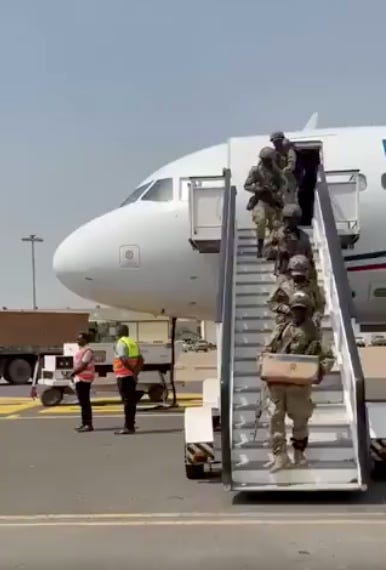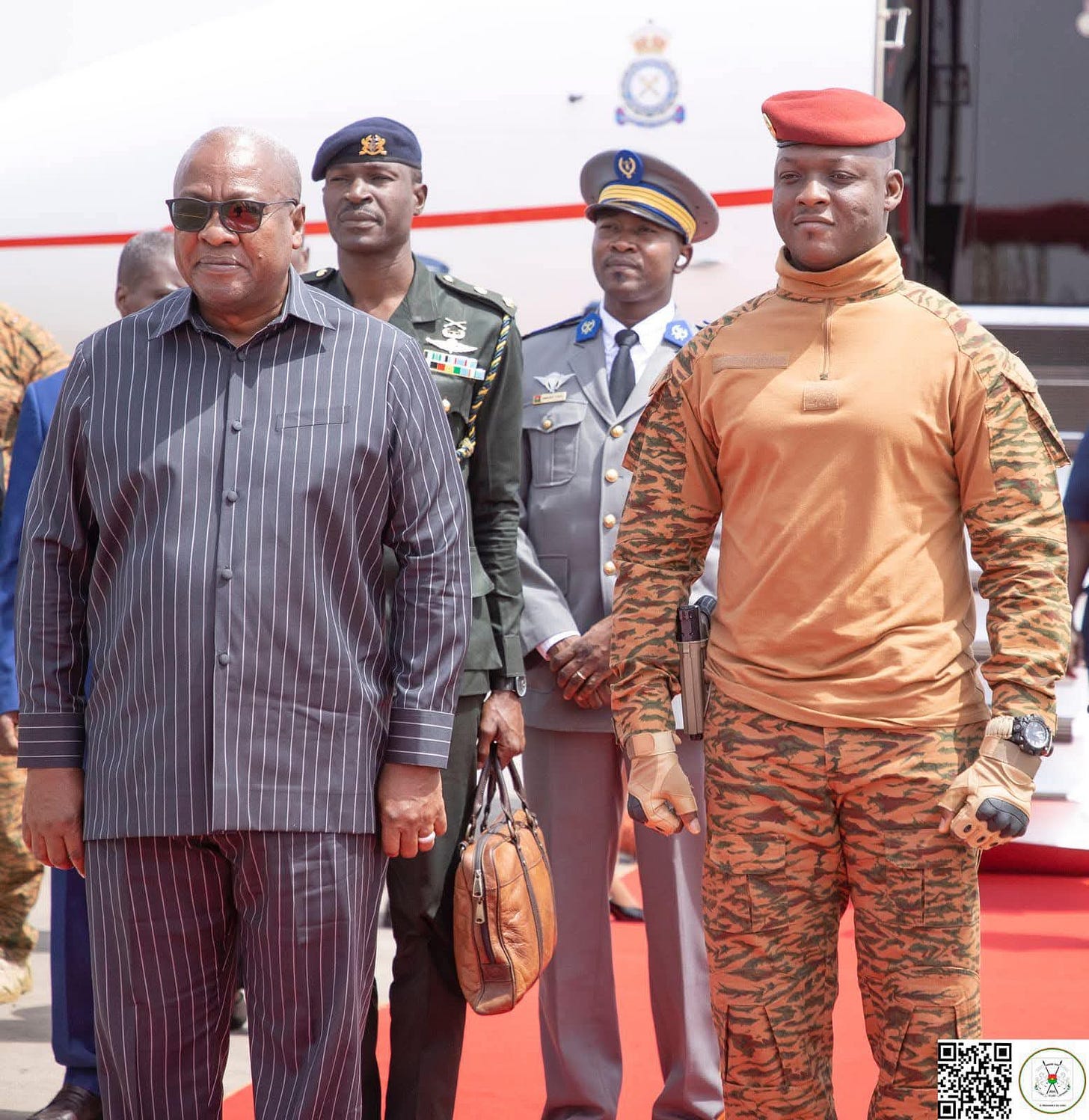The Sub-Saharan Security Review
4 March - 11 March
A Major Conflict Looms on the Horizon in the Horn of Africa
Despite fighting on the same side in the 2020-2022 Tigray conflict, which claimed the lives of at least 600,000 people, the relationship between Ethiopia and Eritrea has long been fraught with tension and hostility.
Tsadkan Gebretensae - a close ally of Ethiopian Prime Minister Abiy Ahmed and a high-ranking member of the Tigray Interim Administration - warned on 11 March that conflict between Ethiopia and Eritrea “seems inevitable”.
Preparations for war are reaching their “final stages”, with Ethiopia’s Tigray region likely to serve as the main battleground, Tsadkan also claimed.
Tensions between the two neighbours have risen significantly since the beginning of the year. In January, Addis Ababa hosted prominent members of the Eritrean opposition, while the President of Eritrea, Isaias Afwerki, was accused by one of Ethiopia's former Presidents of seeking “to reignite conflict” in Ethiopia by exploiting political divisions in Tigray.
For over a year now, Tigray has been marred by an internal rift between rival factions aligned with Getachew Reda, President of the Tigray Interim Administration (TIA), and Debretsion Gebremichael, Chairman of the Tigray People’s Liberation Front (TPLF).
The TIA was formed under the Pretoria Agreement, which ended the bloody war between the Federal Government of Ethiopia and the TPLF, to temporarily govern Tigray.
The peace deal also ordered the Tigrayan army (TDF) to disarm within 30 days; however, more than two years later, the force is still not close to meeting this requirement.
Getachew Reda and the TIA - accused by some of their opponents of acting on the interests of the Federal Government of Ethiopia - are ostensibly seeking to fully implement the Pretoria Agreement.
Meanwhile, the faction led by Debretsion Gebremichael appears determined to regain control over both Tigray, and potentially, Ethiopia, where the TPLF was the dominant political force for decades prior to 2020.
Tensions between the Getachew and Debretsion have escalated significantly in recent months. At the end of January, Getachew accused the TDF of attempting a “soft coup” after more than 200 senior officers aligned with Debretsion called for the dissolution and restructuring of the TIA.
Debretsion’s faction has also reportedly met with the Eritrean government on a number of occasions, seeking support for a potential conflict with the Ethiopian Federal Government.
Conditions have further deteriorated over the past week. Several days ago, the TIA ordered an immediate end to all military movement, following reports that TDF units were being mobilised without authorisation.
It also tried to suspend three high-ranking military commanders on 11 March for “dragging the region into internal conflict.” Debretsion has pushed back against these efforts, however, claiming they are unlawful.
The rising pressures in Tigray reportedly erupted into violence on 11 March. TIA officials were allegedly ousted from Eritrea’s second largest city, Adigrat, by TDF forces allied with Debretsion, while clashes have been recorded in numerous other locations in Tigray.
The Debretsion faction has purportedly begun mobilising forces to take control of cities in all directions from Mekelle. Getachew has also claimed that “external forces” (likely implying Eritrean forces) are involved.
A major conflict involving Tigray, the Ethiopian Federal Government, Eritrea, and other local actors now looms firmly on the horizon. The repercussions of this potential war will be far-reaching and devastating.
Long-Standing Divisions Plunge South Sudan into Crisis
Violence and bloodshed have defined South Sudan’s short history as a nation. A brutal five-year civil war erupted a little under three years after it gained independence from Sudan, costing the lives of over 400,000 people.
The conflict was a byproduct of a power struggle between Salva Kiir, the current President of South Sudan, and his First Vice President, Riek Machar. Tensions between the two have grown significantly once again, raising fears that South Sudan may be plunged into another major internal conflict.
On 4 March, the White Army - an ethnic militia with close ties to First Vice President Machar - overran a military base in the western city of Nasir, Upper Nile state.
This move followed several purported attacks in February by the military (SSPDF), overseen by President Kiir, on forces loyal to Machar in the country’s west.
In response to the deadly clash at the SSPDF base in Nasir, security forces arrested several prominent figures allied with Machar in the capital, Juba, on 5 March.
Among them were Petroleum Minister Puot Kang Chol, Deputy army chief, General Gabriel Duop Lam, and a number of other high-ranking military leaders. Machar’s residence in the capital was also surrounded by soldiers.
Weeks prior to this, Machar had warned that the government’s decision to dismiss several of his close allies put the 2018 peace agreement between him and Kiir in jeopardy.
The recent arrests have been followed by similar threats, with the spokesman for Machar’s SPLM-IO party stating that they placed “the entire peace agreement at risk”.
Internal pressures rose further on 7 March, after a UN helicopter evacuating SSPDF troops from Nasir was fired upon. Among the dead were a general, several South Sudanese troops, and a crew member, while several others were wounded.
The mounting tensions have seen the UN warn of “an alarming regression that could erase years of hard-won progress” in the country, while the US has instructed all its non-emergency staff in South Sudan to leave immediately.
Ugandan special forces have recently arrived to secure the capital, with Uganda's military chief General Muhoozi Kainerugaba stating that any action taken against Kiir "is a declaration of war against Uganda".
The deployment of the Ugandan military has lowered the likelihood of major violence erupting soon in Juba, though it is unlikely to reduce levels of violence in western South Sudan, meaning major internal conflict remains a distinct possibility.
Moreover, while it is unclear how long Ugandan troops will remain in the country, their presence will do little to curtail the long-standing political tensions between Machar and Kiir.
The latest bout of hostilities has been attributed in part to the economic pressures placed on President Kiir by the conflict in neighbouring Sudan, further demonstrating the destabilising effect prolonged fighting between the Sudanese Armed Forces (SAF) and the Rapid Support Forces (RSF) is having on the wider region.
Alarmingly, the eruption of a major internal conflict in South Sudan would likely cause violence in the two neighbouring states to converge, a potential scenario that would exacerbate the already acute levels of violence and dire humanitarian conditions facing millions in both countries.
Ghana’s President Moves to Repair Ties with the Sahel States
In January 2013, newly-elected President of Ghana, John Mahama, forebodingly warned of the threats facing the stability of West Africa should Islamist militants be allowed to consolidate a foothold in northern Mali.
Despite these public concerns, Mahama likely did not anticipate the cataclysmic effect extremist violence in northern Mali would have on the regional landscape over the coming years.
After losing elections in 2016, Mahama reentered office early this year facing a very different political reality. Islamist militants are now launching frequent attacks across five West African states and becoming increasingly active in his country’s north.
The violence of these groups has also led to deep fissures within the West African community. The military leaders of Mali, Burkina Faso, and Niger - who assumed power via a series of coups between 2020-2023 - have left the regional bloc, Economic Community of West African States (ECOWAS), and formed the Alliance of the Sahel States (AES).
Mahama has recently been leading a diplomatic effort to repair ties with the Sahel states, in hopes of stemming the spread of the same Islamist groups that he ominously sounded the alarm over 12 years ago.
The Ghanaian leader met with the President of Côte d’Ivoire, Alassane Ouattara, in Abidjan on 6 March. In a public statement, Mahama outlined his desires to serve as a conduit between ECOWAS and AES to improve regional stability.
Ouattara reaffirmed Mahama’s desire, voicing his hope that “these three brother countries” would be willing to come back into the fold.
Over the following days, President Mahama travelled to Bamako, Niamey, and Ouagadougou to hold bilateral summits with President Assimi Goïta, General Abdourahamane Tchiani, and Captain Ibrahim Troaré.
Mahama emphasised the centrality of these meetings in regaining trust and opening dialogue, but it remains to be seen if his efforts will produce any tangible outcomes over the longer term. As the Ghanaian leader noted, repairing these fractured relations will take time and considerable effort.
The success of Mahama’s outreach will depend on whether the leaders of AES view his as mutually beneficial, or an self-serving endeavour aimed at rebuilding ECOWAS’ diminishing credibility.
On 10 March, Mahama reiterated the importance of his recent travels, concluding that “in Africa, we say when your neighbour’s house is on fire, you have to help them quench it. Otherwise, it will spread to your own house.”
While this proverb conveys the correct sentiment, it is also a significant understatement. An inferno of extremist violence is raging in the heart of West Africa, and the region’s littoral states are fighting an uphill battle to contain the flames creeping into their northern regions.
West Africa’s fractured relations are obstructing the levels of cooperation needed to combat the proliferation of extremist militants from the Sahel.
If ties with AES are not swiftly repaired, the wider region may soon find itself confronted by an unprecedented crisis.
DRC Offers Minerals in Exchange for US Security Assistance
The endless cycles of violence and conflict that have plagued the Democratic Republic of the Congo (DRC) throughout its history have been fuelled by its natural resources, their longevity sustained by the riches these minerals yield.
Many have attributed the M23’s recent campaign of violence in the country’s east as yet another example of this now all-too-familiar tale, with the Rwanda-backed group having seized swathes of resource-rich territory over the past several years.
Conflict between the Congolese government and M23 has escalated in recent months, with the rebels turning their attention toward gaining control of major towns and cities. The Congolese armed forces (FARDC) and its security partners have been largely unable to halt the group’s advances.
As the battlefield initiative remains largely in the hands of M23, Congolese President Felix Tshisekedi is reportedly seeking to leverage his country’s vast reserves of critical minerals to turn the tide.
Talks between the Congolese government and the US over a deal that would give American companies mining rights in exchange for military support and equipment have reportedly gained momentum in recent weeks.
The potential deal, reportedly proposed by the DRC last month, has been well-received by the Trump administration. The US president has been vocal in his desire to gain greater access to critical minerals, having recently suggested his country should take control of Greenland and enter a resource deal with Ukraine.
It remains to be seen if and when a deal between the DRC and the US will take shape, but the Congolese government needs immediate assistance if it is to reverse the gains M23 has made in recent months.
The past week has seen M23 claim further victories in the eastern DRC. Most notably, on 9 March, M23 reportedly captured Nyabiondo, a strategic town in North Kivu, along with several other nearby villages. The group also made incremental advances elsewhere in the province, as well as in South Kivu.





